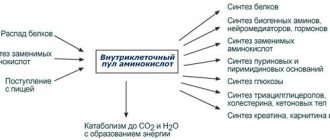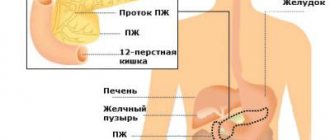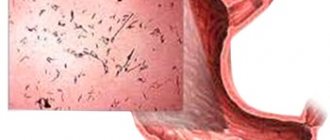Various serious diseases of the small intestine and the entire gastrointestinal tract are quite common. These can be infectious and non-infectious diseases, infectious parasitic diseases and others. That is why people are interested in the question of how to check the small intestine in order to be sure that your health is in perfect order.
How does small intestine cancer develop?
Oncology begins with the appearance of just one altered cell in the body. It arises due to exposure to harmful substances, various diseases or simply random failures, grows and multiplies. Over time, there are many of them, they form a tumor and destroy the tissues in which they develop. Most of these cells are identified and destroyed by the immune system, but some of them are able to resist it - they secrete special proteins, thanks to which our natural defense does not consider them dangerous.
The possibilities of cancer do not end there - its cells enter the bloodstream and lymphatic system. The lymphatic system complements the cardiovascular system. The lymph circulating in it - the intercellular fluid - washes all the cells of the body and delivers the necessary substances to them, taking away waste. In the lymph nodes, which act as “filters,” dangerous substances are neutralized and removed from the body. systems, spread throughout the body, become established in various organs and create metastases in them - new foci of the disease.
To better understand the disease, we need to understand how our digestive system works.
After we chew and swallow food, it enters the esophagus, a narrow muscular tube through which it passes into the stomach, where it is partially digested. There it turns into a thick liquid and is excreted into the small intestine, where large molecules continue to be broken down into small ones and most of the nutrients are absorbed.
The small intestine of an adult is about 4.5-6 meters long and consists of 3 sections:
- Duodenum
, which receives substances necessary for digestion and decomposing carbohydrates, proteins and fats - produced by the liver and pancreas. This is where most cancers begin. - The jejunum and ileum,
where nutrients from the foods we eat are absorbed into the blood.
The ileum drains into the colon, where water and some minerals are absorbed, and the resulting waste moves to the rectum, where it is stored until it leaves the body through the anus.
Differences
The main difference between the two sections of the intestine is the functions they perform. After all, the main function of the small intestine is the absorption of nutrients, and the large intestine is fecal formation. They also have different diameters, in thick ones it ranges from 4 to 9 cm, in thin ones - from 2 to 4 cm.
The color of the large intestine should be grayish, and the small intestine should be pink. The large intestine has outgrowths and protrusions. The large intestine is approximately 5.5 mm thick, and the small intestine is almost 2 times thinner. Based on all of the above, you can understand the principles by which the digestive system works. Now you know where the intestines are in women
, and what functions it performs.
Types of Small Bowel Cancer
Doctors identify several types of dangerous neoplasms in this part of the digestive system, each of which develops in certain cells:
- Adenocarcinomas
are cancers of the small intestine that begin in the glands lining the inner surface of the organ. They account for approximately 1 in 3 cases of cancer. - Carcinoid,
or
neuroendocrine, tumors
arise in cells that help control the secretion of digestive juices and the movement of food through the gastrointestinal tract. - Lymphomas
appear in immune cells - lymphocytes, whose main task is to fight infections and tissue damage. - Sarcomas
develop in various types of connective tissue, such as muscle. Their most common subtype, gastrointestinal stromal tumors, begin in so-called Cajal cells, which signal the muscles of the gastrointestinal tract to contract.
Digestive system diseases and sleep problems
Sleep disturbance is a situation that affects at least every 4-5 people on the planet. In many cases, the cause of poor sleep is various diseases, including diseases of the human digestive system.
“Hunger pains” with ulcers are well known, waking up in the middle of the night and disrupting sleep. Bloating, diarrhea, constipation, nausea, heartburn, and vomiting can interfere with sleep.
Snoring, apnea, insomnia or other problems? Contact the Sleep Medicine Center at the Rehabilitation Clinic in Khamovniki. We will definitely help you! Ask questions and schedule a consultation by phone.
In addition, sleep disorders can themselves provoke the appearance of digestive disorders. For example, with obstructive apnea syndrome, when patients have snoring and sleep apnea, nighttime heartburn and belching are common symptoms.
If you are worried about several problems at once, namely sleep disturbances and digestive disorders, it makes sense to report your complaints to a somnologist. At the Sleep Medicine Center at the Rehabilitation Clinic in Khamovniki, you will be able to provide the necessary assistance.
Why does small intestine cancer develop?
To date, the exact causes of the development of small intestinal cancer are not known to scientists and doctors - they only know about the factors that increase the likelihood of its development. Having one, two or three of them does not mean that a person will necessarily become a patient of an oncologist.
These include:
- Crohn's disease
, which causes the immune system to attack the gastrointestinal tract. - Poor nutrition
– an excess of red meat, salty, fatty and smoked foods in the diet, as well as a lack of fruits and vegetables. - Celiac disease
is an abnormal reaction of the body to the protein gluten, which is found in wheat and other types of grains. The immunity of its owners damages the intestinal mucosa, forcing it to produce new cells, each of which may turn out to be tumor cells. - Familial adenomatous polyposis
is the presence of many polyps - tissue growths on the intestinal wall, which over time can turn into a malignant, that is, life-threatening neoplasm. - Age
: this type of cancer most often develops in people aged 60 to 70 years. - Cystic fibrosis
is damage to the glands, respiratory and digestive systems due to the accumulation of thick mucus in organs and tissues. - Smoking and alcohol
: Some studies have shown that inhaling toxic tobacco smoke and drinking alcoholic beverages can trigger the development of the disease. - Other polyposis syndromes
: Lynch, which increases the chances of developing any type of dangerous tumor in people under the age of 50, or Peutz-Jeghers, which leads to the appearance of polyps in various parts of the body. - Having colon cancer
increases the likelihood of developing small intestinal cancer.
Endoscopic department of the oncology center Lapino 2
What is the intestine, anatomy
The intestines are one of the most important human organs.
The intestine is the human digestive and excretory organ. The three-dimensional image clearly demonstrates the structure diagram: what the human intestine consists of and what it looks like.
It is located in the abdominal space and consists of two segments: thin and thick.
There are two sources of its blood supply:
- Thin - we supply blood from the superior mesenteric artery and the celiac trunk
- Thick - from the superior and inferior mesenteric arteries.
The starting point of the intestinal structure is the pylorus of the stomach, and it ends at the anus.
Being in constant activity, the length of the intestine in a living person is about four meters; after death, the muscles relax and provoke its increase in size to eight meters.
The intestines grow along with the human body, changing size, diameter, thickness.
So, in a newborn child, its length is about three meters, and the period of intensive growth is the age from five months to five years, when the child moves from breastfeeding to a common “table” and increased portions.
The intestine performs the following functions in the human body:
- Provides the supply of hydrochloric acid to the stomach for the primary processing of food;
- Actively participates in the digestive process, breaking down eaten foods into individual components and taking from them the microelements and water needed by the body;
- Forms and removes feces from the body;
- Has an important effect on the human hormonal and immune systems;
Signs and symptoms of small bowel cancer
The symptoms of the disease are similar to other fairly common health problems. Often people do not pay attention to them or take them for a normal digestive problem, as a result of which a considerable part of patients consult a doctor several months after their appearance.
Abdominal pain is often the first symptom of cancer.
– it comes and goes, often occurs after eating, but does not cause serious discomfort to its owner.
As the tumor grows, the intestinal lumen narrows, the passage of digested food through it slows down, and the discomfort intensifies. When it becomes large enough and completely blocks the passage, a person experiences obstruction of the digestive tract, which leads to severe pain, nausea and vomiting
.
Sometimes the tumor begins to bleed. If the blood flows slowly, the patient's number of red blood cells - cells that carry oxygen from the lungs and deliver them to other tissues - gradually decreases, causing weakness and fatigue
.
If this happens quickly, the patient becomes dizzy and faint,
and his
stool
becomes
black
and
tarry
.
Quite rarely, duodenal cancer causes jaundice
– yellowing of the skin, mucous membranes and whites of the eyes. This occurs when the tumor grows and the bile duct is blocked, due to which the contents of the liver cannot enter the intestines. As a result of this blockage, bile, necessary for digesting food, and the substance it contains, which colors the tissues yellow, enter the bloodstream.
In rare cases, cancer leads to the appearance of perforations - holes in the intestinal wall through which the contents of the organ exit into the abdominal cavity. Signs of this condition may include severe abdominal pain, nausea and vomiting.
Parietal digestive insufficiency
Structure of the small intestine
These disorders are caused by pathological changes in mucous tissues, as well as intestinal microvilli. The disease occurs as a result of chronic inflammatory processes, lipodystrophy, and enteropathy. Symptoms are similar to intestinal dyspepsia. Therefore, additional examinations are needed for a final diagnosis. The treatment is also similar.
Features of intracellular digestive insufficiency
The basis of this disease is carbohydrate intolerance. Pathology can be congenital or acquired. Clinically, the disorder is manifested by strong fermentation in the intestines, after the intake of carbons that have not undergone the splitting process. The patient suffers from regular diarrhea. Feces are copious, liquid and foamy.
Therapy involves eliminating carbohydrates from the diet. Additionally, medications are prescribed that can stimulate the formation of enzymes in the intestines. This includes folic acid, anabolic hormones, calcium, iron and vitamins. Malabsorption syndrome is directly related to:
- morphological transformations of mucous tissues;
- disorders of food digestion;
- difficulty moving food masses;
- intestinal dysbiosis;
- problems with intestinal motility
Intestinal absorption is impaired as a result of tumor changes, which are extensive, resections, diseases of the hepatobiliary system, pancreatitis, circulatory problems, inflammatory processes and irradiation of the abdominal cavity.
Poor nutrition is one of the causes of small intestinal diseases
All of the above processes certainly lead to pathological changes in the crypts and microvilli. This in turn leads to disruption of the blood supply to the intestinal walls. The mechanisms of intestinal absorption begin to work incorrectly. The body stops absorbing amino acids, carbohydrates, fats, vitamins and mineral salts.
Diagnosis of small intestine cancer
Diagnostics is necessary not only to identify oncology - its data allows us to understand how far the disease has spread and what treatment is best for a person.
You can undergo a full examination for small intestinal cancer at Onko. We have the most modern equipment and a team of highly qualified specialists who guide the patient from diagnosis to any treatment.
Diagnosis begins with a physical examination, questioning about symptoms, possible risk factors and family health problems. Then the doctor prescribes a whole list of studies:
- Blood tests
: show its composition and the number of oxygen-carrying red blood cells, the level of which may decrease due to bleeding caused by cancer. - FGDS
-
fibrogastroduodenoscopy
: examination of the duodenum using an endoscope - a thin flexible tube with a light source and a camera at the end. The device is inserted into the mouth, passes through the esophagus and stomach, and allows not only to assess the condition of the tissues, but also to remove small pieces of them, which are then sent to the laboratory. - Capsule endoscopy
: A painless procedure involving swallowing a small capsule about the size of a large tablet. It passes through the entire digestive system, takes thousands of pictures transmitted to a special wearable device, and leaves the body naturally. - Balloon enteroscopy
: insertion through the mouth or anus of a special endoscope equipped with one or two balloons that are secured in place, allowing a close and detailed examination of the intestinal wall. - Colonoscopy
: insertion of a thin, flexible tube with a light source and a camera at the end through the anus. This procedure is used to study the condition of the final part of the small intestine and take tissue samples from suspicious areas. - Imaging tests, such as CT
or
MRI
: create clear images of organs using X-rays, magnetic fields, or radioactive substances. They are prescribed to detect a tumor, search for signs of re-development of the disease and identify metastases - additional foci of oncology, - Biopsy: taking small pieces of tissue and sending them to a laboratory for testing is the only method that allows you to make an accurate diagnosis and determine whether suspicious areas are cancerous. This procedure is usually performed simultaneously with endoscopic examinations or colonoscopy.
duodenum
The beginning of the structure of the small intestine opens - the duodenum, stretching behind the pylorus of the stomach, fitting the head and partly the body of the pancreas, thereby forming the shape of a “horseshoe” or semi-ring and flows into the jejunum.
Consists of four parts:
- Upper;
- Descending;
- Lower;
- Rising.
In the middle of the descending part, at the end of the longitudinal fold of the mucous layer, there is the nipple of Vater, which includes the sphincter of Oddi. The flow of bile and digestive juice into the duodenum is regulated by this sphincter, and it is also responsible for preventing the penetration of its contents into the bile and pancreatic ducts.
Stages of small bowel cancer
After a person is diagnosed with small intestine cancer, doctors determine the stage of the disease - find out how far it has spread and what tissues it has damaged. Staging allows specialists to correctly assess the situation, imagine the patient’s approximate prognosis and select the most appropriate treatment for him.
For these purposes, the American TNM system is used, each letter of the abbreviation of which describes tissue damage:
- T the
main tumor; - N
describes the condition of the lymph nodes - small organs of the lymphatic system. The lymphatic system complements the cardiovascular system. The lymph circulating in it - the intercellular fluid - washes all the cells of the body and delivers the necessary substances to them, taking away waste. In the lymph nodes, which act as “filters,” hazardous substances are neutralized and removed from the body, retaining and neutralizing hazardous substances; - M1
indicates the presence, and
M0
- the absence of metastases - additional foci of cancer in other organs located far from the main tumor.
As a rule, cancer begins to develop in the mucous membrane
– the inner lining of the intestine, and as it grows it damages the deeper layers:
- second , the submucosa
, consisting of connective tissue; - muscular
, contracting to move food; - subserous
and
serous
, or visceral peritoneum - thin films covering the gastrointestinal tract.
Doctors distinguish 5 stages of adenocarcinoma: 0: tumor cells are present only in the epithelium - the upper layer of mucosal cells. I: they have penetrated deep into the first or second layers of the organ wall. IIA: muscular or subserous membranes are damaged. IIB: the visceral peritoneum or tissues located next to the intestines are damaged. IIIA: Cancer is found in 1 or 2 nearby lymph nodes. IIIB: cancer is present in 3 or more lymph nodes. IV: metastases have appeared in the body - additional tumors in other organs or tissues located far from the small intestine.
Blind
The initial section of the human large intestine, located according to the scheme in the right iliac fossa, framed everywhere by the peritoneum, is arranged in the shape of a pouch.
From the posterior wall of the cecum stands out its appendage, nothing more than the appendix, a tubular appendage about ten cm in size and one cm in diameter, which performs secondary functions necessary for the human body: it produces amylase, lipase and hormones involved in the work of intestinal sphincters and peristalsis.
Treatment of small intestine cancer
Treatment of any type of oncology is a complex task, the solution of which requires several doctors: a surgeon, gastroenterologist, radiologist, chemotherapy and others.
Onco has a whole team of world-class specialists who care for the patient completely - from examination and diagnosis to prescribing and carrying out any therapy. With us, you don’t have to wonder “what to do next?” – we draw up a clear action plan and carry out all the necessary interventions on time – without queues, delays or wasted time.
Therapy is selected for each person individually - it depends on his age, general health, as well as the type and stage of the disease.
The main treatment for this type of cancer is surgery
. The neoplasm is removed completely if it is located only in the place where it originated - in the small intestine or the tissues closest to it. As it grows and the changed cells spread throughout the body, such an intervention alleviates the patient’s condition and reduces the symptoms caused by the blockage of the digestive system.
Chemotherapy
– introduction into the body of special drugs that enter the bloodstream and destroy cancer cells in any part of the body. It is prescribed in several situations:
In the case of adenocarcinoma of the small intestine, which is not very sensitive to “chemistry,” drugs such as Capecitabine, 5-fluorouracil, Oxaliplatin and Irinotecan are often used. Since these substances affect not only cancer cells, but also healthy cells, people who take it often develop severe side effects. The most common ones are nausea and vomiting, loss of appetite, hair loss, mouth ulcers, diarrhea, shortness of breath - feeling short of breath, bleeding or bruising from minor cuts or injuries, and constant fatigue.
Radiation therapy
– destruction of the tumor using radiation. This method is prescribed to destroy remaining cancer cells after surgery and as palliative treatment. The goal of such an intervention is to alleviate the patient’s condition and improve his quality of life - stopping bleeding or reducing pain. Before it is carried out, a team of specialists makes careful measurements: they find the correct angles at which the rays are delivered and select the exact dose for each individual person. The procedure itself lasts only a few minutes and does not cause discomfort. Its main side effects are fatigue, nausea and vomiting, diarrhea, and skin changes in the treated area such as redness, peeling or blistering.
Immunotherapy
– taking medications that strengthen a person’s own immunity and help him detect and destroy cancer cells.
Be sure to inform your doctor about any changes in your health - he will select the most suitable treatment regimen for you or prescribe medications that will alleviate your condition.
Oncoproctology department of the oncology center Lapino 2
Treatment of diseases
If the disease is acquired, then to cure it it is necessary first of all to eliminate the underlying disease. In addition, therapeutic measures are carried out. They include:
- taking enzymes. For example, mezim, pancreatin and others;
- taking medications intended for parenteral nutrition. These are amino acids, fat emulsions, concentrated glucose, protein hydrolysates;
- taking anabolic steroids. For example, retabolil or nerobol;
- in the presence of intestinal dysbiosis, antibiotics may be prescribed. They will destroy the intestinal flora. After this, it will be necessary to use biological preparations that will restore the intestinal biocenosis. These drugs are Lactobacterin, Bifikol, Colibacterin and others;
- taking medications that help reduce hypoxia of the intestinal walls. They are most often represented by solutions and vitamin complexes;
- taking medications that thicken stool. These include calcium and bismuth;
- taking drugs that promote the adhesion of fatty acids - activated carbon
All of the diseases described above have a very negative impact on a person’s well-being and quality of life. Therefore, it is important to make a timely diagnosis and begin adequate treatment. By self-medicating, you can further aggravate the situation and trigger the disease even further. Diagnosis consists of examination and a series of tests.
Treatment of operable and inoperable small intestinal cancer
Treatment methods for this type of cancer depend on the possibility of complete surgical removal of the tumor.
Operable neoplasms
– those that can be completely cured with surgery are removed along with a small amount of nearby healthy tissue:
- when it is located in the first part of the organ, pancreatoduodenectomy is usually performed - resection of the head of the pancreas and duodenum;
- if it is detected in the final section, as a rule, removal of part of the colon is required;
- if the cancer is located in other areas of the small intestine, the patient is prescribed resection of the area containing the altered cells.
If nearby lymph nodes are damaged, your doctor may recommend chemotherapy or radiation therapy to kill any damaged cells remaining in the body.
Inoperable
Tumors are considered to be those that have damaged nearby tissue, spread to other organs, or are found in a person unable to undergo major surgery. In such cases, it is possible to carry out chemotherapy, radiation or immunotherapy to stop the growth of the tumor, slow down its development, reduce symptoms and improve the patient’s quality of life.
What is intestinal dyspepsia (insufficiency of cavity digestion)
Dyspepsia is associated with a violation of the secretory functionality of the stomach and organs that are located nearby (liver, pancreas, gall bladder). A major role in the occurrence of abdominal insufficiency is played by disruption of intestinal motor functions and stagnation or accelerated passage of its contents. The disease appears after:
- intestinal infections. They influence the quantitative and qualitative composition of microflora;
- regular unbalanced diet. Occurs from an excess of carbohydrates, fats and insufficient amounts of vitamins;
- psychological and emotional shocks. They inhibit the secretion of the digestive glands;
- chronic inflammatory processes
Intestinal dyspepsia is usually characterized by the presence of bloating, as well as rumbling and transfusion in the intestines and gases. There are problems with stool, manifested by diarrhea. In this case, the feces have a putrid or sour odor.
Prognosis and survival for small intestinal cancer
The outlook for each person is individual and depends on a large number of factors - age, general health, type of disease, its stage and response to treatment.
To understand the approximate prognosis for cancer development, doctors use a special term - “five-year survival rate”. It doesn’t say anything about the chances of a particular patient - it’s just statistical data that shows what percentage of patients with a certain type of cancer at a particular stage remain alive 5 or more years after the tumor was discovered.
- at localized stages, while the tumor is located only in the small intestine - approximately 85%
- at regional level, when nearby tissues or lymph nodes are damaged – about 76%;
- with the spread of altered cells to organs far from the intestines, such as the liver - 42%.
For carcinoid tumors of the gastrointestinal tract: 97%, 95% and 67%, respectively. For stromal formations: 93%, 80% and 55%.
The overall five-year survival rate for small intestinal lymphoma is approximately 70%.
Functions and main parts of the colon
The thick section performs no less important functions than the thin one. The process of absorption occurs in reverse (readsorption). About 95% of electrolytes and water are absorbed. When 2 kg of chyme arrives from the small intestine, 0.2 kg of feces remains after absorption.
- The transfer function is the accumulation, storage of feces and evacuation to the outside through the anus. Feces travel through the large intestine for more than 12 hours;
- excretory function is the regular removal of feces;
- production of mucus by the glands of the inner surface of mucus;
- cellulose breakdown, protein processing by active microorganisms (microflora) living in the organ for further removal of decay.
The thick section consists of three parts:
Colon
The main part of the large intestine is located according to the structure between the cecum and rectum.
At the junction with the cecum, the cecal ascending sphincter is located. The colon is divided into the following segments:
- Ascending;
- Transverse;
- Falling;
- Sigmoid.
Here, water and electrolytes are absorbed in large quantities, as well as the transformation of liquid chyme into hardened, formed feces.
Straight
Located within the pelvis and without torsions, the rectum completes the structure of the large intestine, starting from the sigmoid colon (level of the third sacral vertebra) and ending with the anus (perineal area). This is where stool accumulates, controlled by the two sphincters of the anus (internal and external). A cross-sectional diagram of the intestine demonstrates its division into two sections: narrow (anal canal) and wide (ampullary section).









